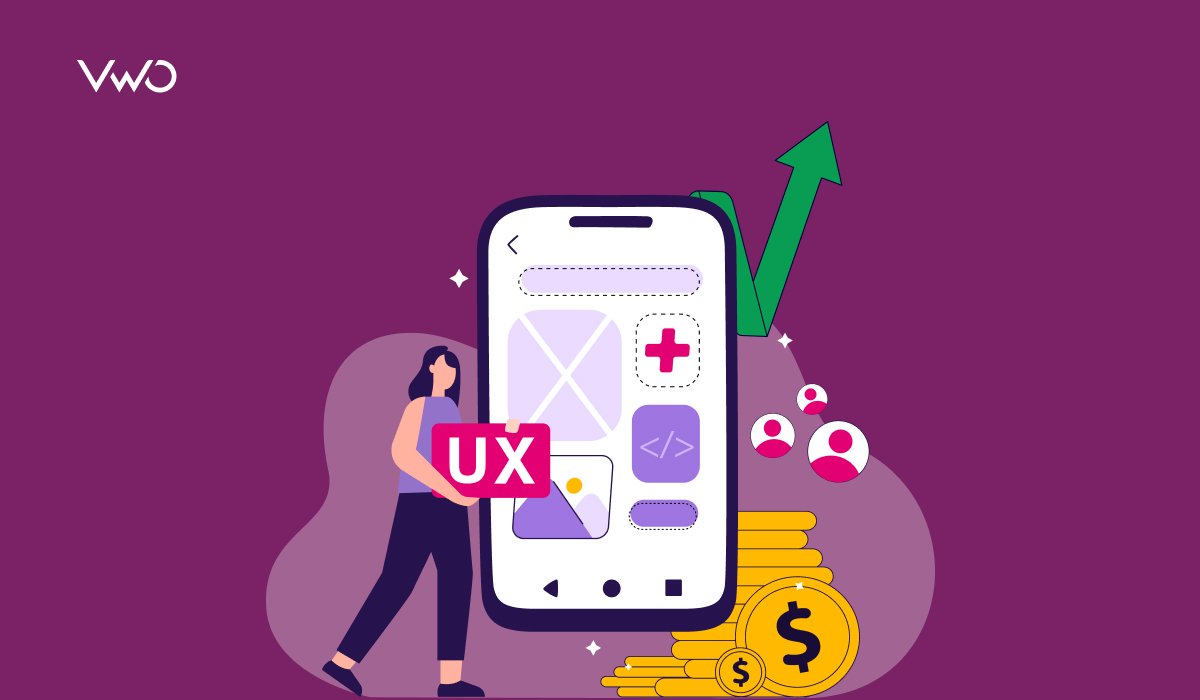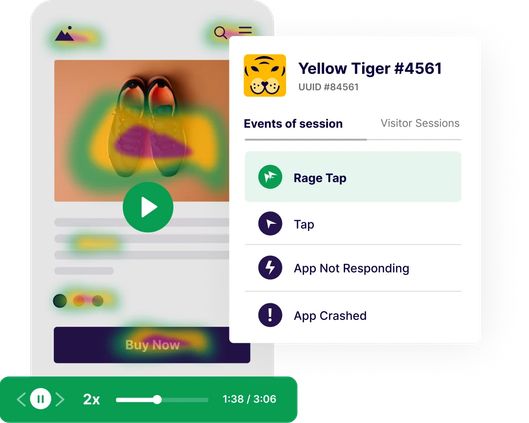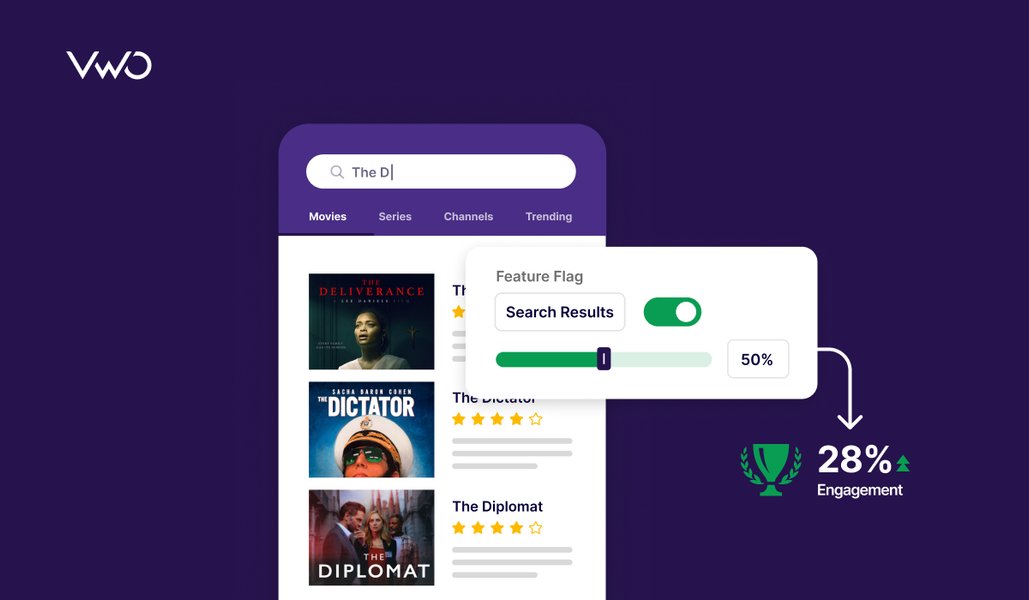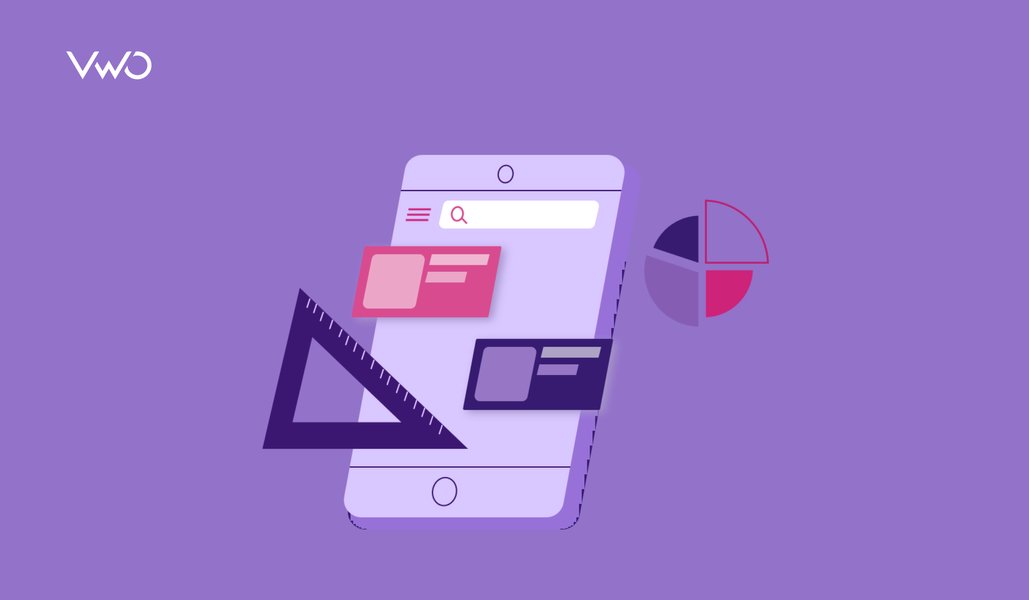7 Mobile App Usability Testing Tools to Enhance UX & Drive Conversions
A great mobile app experience isn’t accidental; it’s shaped by intentional testing and real user insights.
As users demand faster, smoother, and more intuitive journeys, 84% of customer-centric companies are making mobile experience a top priority. Usability testing plays a key role in this shift, helping teams identify friction, refine user journeys, and improve conversion rates.
In this blog, we explore 7 leading mobile usability testing tools that empower teams to turn user behavior into actionable improvements and deliver mobile apps that truly perform.

7 Best mobile app usability testing tools: Quick glimpse
Disclaimer: The pros and cons listed are based on reviews and feedback from third-party sites such as G2, TrustRadius, and other sources.
7 Best mobile app usability testing tools: Detailed overview
1. UXCam

UXCam is a mobile-first analytics platform that unifies product metrics and visual experience data to help teams optimize app usability. With features like funnels, retention dashboards, session replays, and heatmaps, it enables a clear view of how users interact with each screen and flow.
As a usability testing tool, UXCam helps teams quickly identify friction points, navigation gaps, and interface issues by analyzing real user behavior. This enables effective mobile usability testing, data-backed decisions that improve user experience, and reduces drop-offs.
Features
Session Replays, Heatmaps, User Segmentation, Reports & Dashboards, Custom Event Tracking, User Journeys, Crashes, Performance Monitoring, Tagless Autocapture, Smart Events, Funnel Analytics
Pricing
- Free trial: 14-day access to all Growth plan features, 100k sessions, and 1M custom events per month.
- Free: 3000 monthly sessions, and limited access to session replays and filters.
- Paid: Custom pricing can be requested.
Pros:
- Makes crash debugging easier by allowing teams to reproduce and analyze issues directly from user sessions.
- The user-friendly interface makes it easy for teams to review and analyze data.
Cons:
- Sometimes, there’s a slight delay in uploading session replays after user activity.
2. UserTesting

UserTesting is a mobile experience platform that captures real user interactions through live screen and camera recordings, revealing how users behave in natural environments. It helps uncover the impact of distractions, poor connectivity, or context-specific usability challenges.
It also supports comprehensive user testing through interviews, sentiment analysis, and real-time feedback, offering deeper insight into user intent and perception.
Teams can test UX and UI elements like CTAs, navigation, and layouts to catch friction early. Offline testing and omnichannel journey tracking ensure consistency across touchpoints.
Features
Card Sorting, Benchmarking, Sentiment Analysis, Tree Testing, Prototype Testing, Website Testing, AI-powered Analytics, Customer Journey Mapping, Feedback Engine, Unmoderated Tests
Pricing
- A free trial and customized pricing can be requested.
Pros:
- UserTesting makes it fast and easy to reach users and collect feedback, helping speed up product decisions.
- It offers a wide range of test types and a strong participant panel, allowing unlimited testing with detailed recordings.
Cons:
- The interface offers many options, which can feel overwhelming for non-researchers; more guidance would help simplify the experience.
- Participant quality could be improved for newer features like the survey tool.
3. VWO

VWO combines behavioral analytics and experimentation to help teams identify and fix friction in real user journeys. By tracking gestures, taps, navigation patterns, and drop-offs, VWO uncovers usability issues that impact engagement, retention, and conversions.
Its Mobile App Insights Dashboard highlights problems like crashes, ANRs, and rage taps, with direct access to session recordings for faster diagnosis. Teams can visualize user flows, analyze heatmaps, and build funnels to pinpoint where users drop off or struggle.
What makes VWO especially powerful is its high-performance SDKs that support A/B testing across onboarding flows, pricing prompts, checkout steps, and content changes. Teams can run experiments to see how different UI variations affect task completion, engagement, and satisfaction.
This mix of observation + experimentation makes VWO ideal for continuously improving mobile UX based on real behavior, not assumptions.
Start by segmenting audiences based on key user data, like device type, traffic source, and user behavior. Use basic targeting options such as device, location (geo), and time of visit, then scale up with custom variables and conditional logic for deeper precision and more personalized insights.
Features
Smart Sampling, Crash Analysis, Segmentation, Real-Time Reports, Custom Events, Logging & Error Debugging, Traffic Allocation, Advanced Targeting, Conditional Targeting, Time-Based Targeting, Device Type Targeting, Cohort Analysis
Pricing
- Demo is available upon request.
- Free trial: 30 days for mobile insights.
- Paid: Custom plans provided on request.
Pros:
- Helps improve customer journeys and boost sales through A/B testing and in-depth analysis of user behavior.
- Reliable support with 99% CSAT – experts are always available to help with any question or experiment.
Cons:
- Lacks traditional user testing features like moderated sessions and participant recruitment
4. Testbirds

Testbirds is a crowdtesting platform that provides real-world usability and quality assurance testing for digital products across mobile (iOS, Android, native, hybrid), desktop, and IoT devices. By tapping into a global community of testers matched to specific target groups, it delivers insights based on real user behavior in diverse environments.
Unmoderated tests reveal usability issues by capturing user actions and thought processes during task completion, while moderated sessions offer live observation and direct feedback on navigation and design. This helps teams refine digital experiences at every stage of development.
Features
Unmoderated Usability Testing, Moderated User Sessions, Quantitative Usability Testing, Competitor Analysis, Card Sorting, Prototype Evaluation, Customer Journey Testing, Accessibility Testing
Pricing
- Info is not available on the website; Custom pricing can be requested.
Pros:
- The platform allows smooth coordination between testers and product owners, with accurate scheduling.
- User-friendly and reliable platform that simplifies participation in and management of paid testing opportunities.
Cons:
- Tester availability could be improved in certain geo-specific locations.
5. Loop11

Loop11 is a UX research and testing platform that lets teams evaluate websites, apps, and prototypes across devices without coding. It supports both moderated and unmoderated tests, making it easy to run quick checks or in-depth studies on live sites or prototypes.
For mobile usability, Loop11 offers task-based and remote testing on real devices, capturing user interactions in natural settings. It consolidates data from different devices into unified reports that include video and audio recordings, heatmaps, clickstreams, and task success metrics, making it easier to identify friction points and improve the mobile experience.
Features
Online Usability Testing, Mobile & Tablet UX Testing, Moderated & Unmoderated Usability Testing, Prototype Testing, A/B Testing, UX Benchmarking, Functional Testing, Remote Testing, Exploratory Testing
Pricing
- Free trial: 14-day access to all Enterprise features.
- Paid: Starts at $179/month, billed annually.
Pros:
- The interface is intuitive and includes all the essential tools needed for UI/UX research.
- The AI-powered project creator sets up studies in seconds with pre-filled tasks and questions, which can be easily customized and launched.
Cons:
- Adding automated testing tools and enhancing the API for regression testing would improve the platform’s flexibility.
- More customization options for usability tests and surveys would help tailor studies to specific research needs.
6. Lookback

Lookback is a UX research platform designed to capture real-time insights into user interactions with mobile apps and websites. It supports both moderated interviews and unmoderated tests, letting teams observe behavior directly or review task recordings asynchronously.
Its strength lies in user testing through live sessions and LiveShare, enabling real-time interaction, screen sharing, and facial recording to surface meaningful user insights. The Lookback Player centralizes session data, with tools for timestamped notes, highlights, and team chat, making it easy to align on findings and act quickly.
Features
Cloud Recording, Virtual Observation Room, Cross-platform Testing, Moderated and Unmoderated Usability Testing, Participant Management, Transcription, Qualitative Insights
Pricing
- Free trial: 5 sessions included, valid for 60 days on any plan.
- Paid: Begin at $25/month, billed annually.
Pros:
- The interface is easy to use, integrates well with other platforms, and makes video analysis and editing simple.
- It allows us to invite our users for both moderated and unmoderated usability testing.
Cons:
- Some users may face plug-in issues that occasionally lead to missed sessions or connection problems.
7. Maze

Maze is a user research platform that helps teams make faster, insight-driven decisions by integrating user feedback throughout the product lifecycle. Built for speed and simplicity, it allows designers, researchers, and product managers to test prototypes, validate mobile designs, and gather in-app feedback with ease.
It supports user testing methods such as interview studies, card sorting, and tree testing, helping teams understand user preferences, behavior, and decision paths. With the Maze Participate app (beta), native tests can be run on real devices, capturing full-screen, audio, and selfie video recordings.
Task success rates, heatmaps, path flows, and in-app feedback offer a clear view of the user journey, while QR code access and privacy-first onboarding make participation seamless and authentic.
Features
Surveys, Open Card Sorting, Tree Testing, AI Follow-Ups & Analysis, Custom Reports, Advanced Targeting, AI Summaries, Sentiment Analysis
Pricing
- Free: For beginners; 1 study and 5 seats per month.
- Paid: Starts from $99/month, billed annually.
Pros:
- AI-powered follow-up questions and organized response grouping make it easy to understand common user feedback.
- Creating tests and sharing them with a targeted audience is quick and hassle-free.
Cons:
- Editing survey questions after launch is limited, especially for certain formats like card sorting, so any errors may remain.
- There can occasionally be issues with prototype testing or link loading, which may affect the testing experience.
Top mobile app usability testing tools: A quick comparison
| Tools | Features | Pricing |
| UXCam | Session Replays, Heatmaps, User Segmentation, Reports & Dashboards, Custom Event Tracking, User Journeys, Crashes, Performance Monitoring, Tagless Autocapture, Smart Events, Funnel Analytics | Free trial: 14-day access to all Growth plan features, 100k sessions, and 1M custom events per month. Free: 3000 monthly sessions, and limited access to session replays and filters. Paid: Custom pricing can be requested. |
| UserTesting | Card Sorting, Benchmarking, Sentiment Analysis, Tree Testing, Prototype Testing, Website Testing, AI-powered Analytics, Customer Journey Mapping, Feedback Engine, Unmoderated Tests | A free trial and customized pricing can be requested. |
| VWO | Smart Sampling, Crash Analysis, Segmentation, Real-Time Reports, Custom Events, Logging & Error Debugging, Traffic Allocation, Advanced Targeting, Conditional Targeting, Time-Based Targeting, Device Type Targeting, Cohort Analysis | Demo is available upon request. Free trial: 30 days for mobile insights. Paid: Custom plans provided on request. |
| Testbirds | Unmoderated Usability Testing, Moderated User Sessions, Quantitative Usability Testing, Competitor Analysis, Card Sorting, Prototype Evaluation, Customer Journey Testing, Accessibility Testing | Info is not available on the website; Custom pricing can be requested. |
| Loop11 | Online Usability Testing, Mobile & Tablet UX Testing, Moderated & Unmoderated Usability Testing, Prototype Testing, A/B Testing, UX Benchmarking, Functional Testing, Remote Testing, Exploratory Testing | Free trial: 14-day access to all Enterprise features. Paid: Starts at $179/month, billed annually. |
How mobile app usability testing tools drive app engagement and conversions
Creating a successful mobile app isn’t just about features; it’s about how users experience and interact with those features. Usability testing tools play a critical role in helping teams uncover what’s working, what’s not, and why users behave the way they do. By capturing real user feedback and behavior across different devices and conditions, these tools help refine the overall experience, providing insights and ensuring the app delivers value with every tap.
Here’s how usability testing tools directly contribute to stronger engagement and higher conversions:
1. Smoother onboarding flows
Usability testing helps identify where users get stuck or confused during sign-up or first-use experiences. By testing usability and streamlining these steps, apps can reduce early abandonment and improve retention from the very first interaction.
2. Optimized CTAs and layouts
Testing different versions of buttons, navigation menus, or screen layouts shows what drives clicks and engagement. This ensures users are guided intuitively through the app, improving task completion and conversions.
3. Faster issue resolution
Tools like session replays and heatmaps make it easier to spot bugs, crashes, or confusing elements. Fixing these early reduces frustration and improves the overall user experience.
4. Effective A/B testing
Comparing different features, messages, or designs with real users allows teams to roll out only the most effective options. This reduces guesswork and maximizes impact on engagement and sales.
5. Refined user journeys
Behavior analytics reveal how users navigate through the app, from entry points to drop-off screens. These insights help teams redesign flows for better continuity and fewer blockers.
FAQs
It’s the process of evaluating how easily users can navigate and complete tasks within a mobile app, identifying barriers to a smooth user experience.
Mobile app usability testing tools are platforms or software that help assess how real users interact with a mobile app. They capture user behavior, identify usability issues, and provide insights to improve user experience.
Usability testing ensures the app is intuitive, efficient, and user-friendly, reducing drop-offs, boosting engagement, and helping apps perform better in real-world use.
Choose tools that support end-to-end testing, analysis, and collaboration. Key features to look for include:
– Session and screen recordings to capture real user interactions
– Heatmaps to visualize user engagement on each screen
– Task creation and scenario-based testing for structured usability studies
– Moderated and unmoderated testing options to suit different research needs
– Analytics dashboards and reports to track performance and spot trends
– Crash and error reporting to identify technical issues affecting usability
– User recruitment and participant management to reach the right audience
– Cross-device and OS compatibility to ensure broad testing coverage
– Integrations with design and project tools for seamless workflows
Define goals, select tasks for users to perform, recruit participants, run the test using a tool or live session, collect feedback, and analyze results for improvements.
Yes, you can use methods like prototype testing, heuristic evaluations, or simulated user flows to assess usability in early stages. However, involving real users and using various testing methods, remotely or in person, provides more accurate and actionable insights into real-world behavior and experience.
The best tools combine real-user testing (moderated and unmoderated), session recordings, heatmaps, analytics dashboards, and cross-device support. Added value comes from features like user recruitment, crash reporting, and integration with design or development workflows.
Yes, mobile app usability testing tools help improve conversion rates by identifying friction points, uncovering usability issues, and optimizing user flows. This leads to smoother interactions, higher task completion, and ultimately, better engagement and conversions.
Timelines vary based on the method and scope; unmoderated tests may take a few hours, while moderated studies or in-depth analysis may take several days.





![Top 10 A/B Testing Tools for Mobile Apps [2025]](https://static.wingify.com/gcp/uploads/sites/3/2021/01/Feature-image_Mobile-App-AB-Testing-Tool-Copy.png?tr=h-600)











